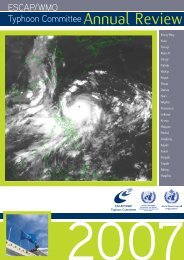TCAR - Typhoon Committee
TCAR - Typhoon Committee
TCAR - Typhoon Committee
Create successful ePaper yourself
Turn your PDF publications into a flip-book with our unique Google optimized e-Paper software.
1. Monitoring and forecasting of water-related<br />
disasters and improvement of these functions<br />
2. Collection and dissemination of information on<br />
monitoring, forecasting, forecasts and warnings, and<br />
water levels<br />
3. Analysis and assessment of the impacts of climate<br />
change on water-related disasters<br />
4. Assistance for prefectural river administrators and<br />
flood-fighting administrators<br />
c. Disaster Prevention and Preparedness<br />
Achievements/Results<br />
d. Research, Training, and Other Achievements/<br />
Results<br />
d-1. Training Seminar on Climate Information and<br />
Forecasting<br />
A Training Seminar on Climate Information and<br />
Forecasting was held at JMA Headquarters in<br />
Tokyo from 4 to 6 November 2008. The event was<br />
attended by 13 participants from 12 countries and<br />
regions engaged in operational long-range forecasting<br />
at NMHSs in East and Southeast Asia, including<br />
8 members of the <strong>Typhoon</strong> <strong>Committee</strong>. Through<br />
lectures and exercises using PCs, the participants<br />
learned how to use the data and products available<br />
on the TCC website for long-range forecasting.<br />
Presentation files used in the seminar are also<br />
available on the site, which can be found at http://<br />
ds.data.jma.go.jp/tcc/tcc/library/library2008.html.<br />
Figure 29 Training seminar participants<br />
(KRA1, 2, 4, 5)<br />
d-2. Reanalysis Project for <strong>Typhoon</strong> Vera (1959):<br />
ReVera<br />
1. Introduction<br />
Fifty years ago, <strong>Typhoon</strong> Vera (1959) made landfall on<br />
Japan’s Kii Peninsula at around 1800 JST(0900 UTC)<br />
on 26 September 1959. It brought tremendous damage<br />
to the country’s islands – especially around the Ise<br />
Bay area – and was the most tragic meteorological<br />
<strong>TCAR</strong><br />
CHAPTER 1 - TYPHOON COMMITTEE ACTIVITIES<br />
disaster in post-war Japan with a casualty toll<br />
exceeding 5,000. The massive damage it caused<br />
to society means that Vera is well remembered in<br />
Japan, and people recall it as the Isewan (Ise Bay)<br />
<strong>Typhoon</strong>. At the time, the one-day track forecast for<br />
Vera was accurate, but the forecast for its speed of<br />
movement suggested that it would be much slower<br />
than it actually was. In addition, the forecast of storm<br />
surge around Ise Bay was 100 to 150 cm at most –<br />
much lower than the actually recorded value of 389<br />
cm.<br />
Recent advances in objective numerical reanalysis<br />
systems have enabled us to obtain long-term<br />
reanalysis data. JMA has started the JRA-55 project<br />
(a long-term reanalysis initiative targeting the period<br />
from 1958 to 2012), which is the successor of the<br />
JRA-25 project for the period from 1979 to 2004.<br />
Using the reanalysis dataset and sophisticated<br />
numerical models, we can simulate past remarkable<br />
meteorological phenomena such as typhoons.<br />
Accordingly, we performed numerical prediction<br />
experiments for Vera to validate its predictability<br />
using the latest forecast techniques together with the<br />
primary outcome from JRA-55 as initial conditions for<br />
track, intensity and storm surge predictions.<br />
2. Track forecast experiment<br />
We performed track predictions using the global model<br />
Figure 30 Track forecast results from the global<br />
ensemble model with 11 members. The line with the<br />
dots shows the best track.<br />
The green line is a control run, and the yellow lines<br />
are derived from the ensemble members.<br />
2009<br />
63

















